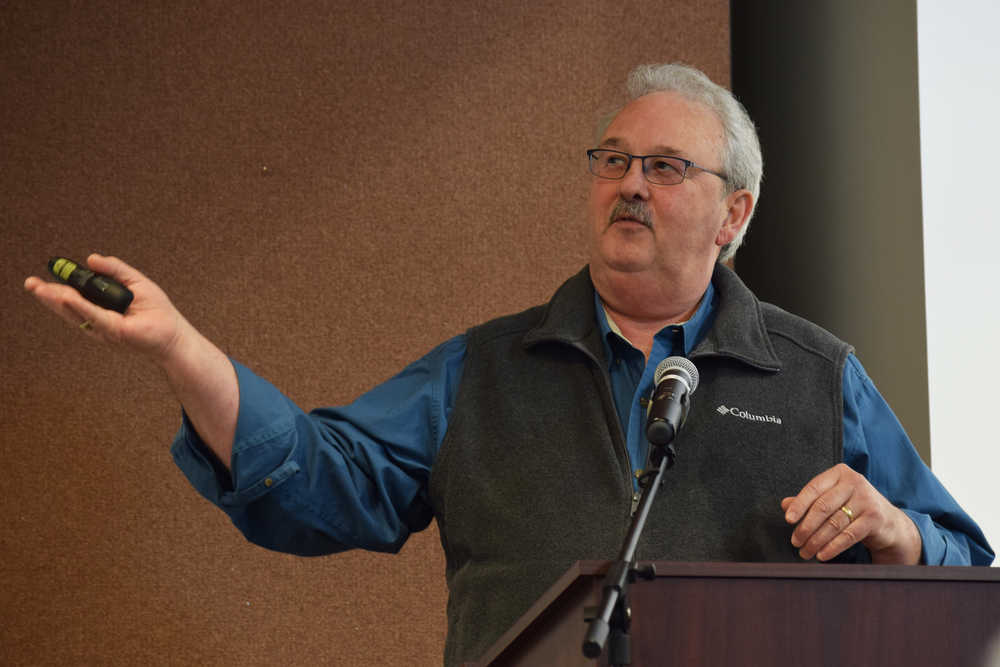Having an emergency plan might be common in households, but local businesses can benefit from emergency planning as well.
Kenai Peninsula Borough Office of Emergency Management Director Scott Walden briefed attendees at Wednesday’s Kenai Chamber of Commerce and Visitor Center Business Luncheon on how to adapt basic emergency protection and recovery skills for business owners. While Walden said much of his advice on emergencies is sought by individuals and families, it is applicable to businesses, too. Having a plan for recovering after a natural disaster or earthquake, he said, is vital.
A basic step is for a business owner to make sure their store or facility can survive for up to 30 days without being able to run, Walden said. Even when disasters or situations don’t affect a business directly, they have the potential to take away customers. This is especially true of situations that require evacuations, like floods or wildfires, Walden said; evacuation of even a few neighborhoods could remove most of a business’s customers or even their employees, he said.
Aviation businesses, especially, should be prepared for canceled trips or restricted flights if there is ever ash fall over the Cook Inlet, Walden said.
“We work closely with the (National) Weather Service to tell you what elevation this ash is and when they think it’s likely to fall,” he said. “So we get a good idea about where we can see the impact occurring across the peninsula.”
Stocking up on dust masks and nonperishable food items is a good way for businesses to protect their employees in the event of ash fall, Walden said.
Walden pointed to Seward, which frequently experiences severe flooding, as a town that has the recovery aspect of emergency response down well. A major factor in the town being able to recover so effectively is that the entire community, from first responders to business owners to residents, come together to help each other, he said.
The groups rely on each other more than one might think, Walden said, evoking the example of the 7.1 magnitude earthquake that rattled the Kenai Peninsula in January and caused road cracks, a gas leak and explosions. The volunteers charged with taking care of displaced families in Kenai were unable to immediately get as much food for them as they would have liked because area stores were all dealing with their own recovery and cleanup after the quake. Had local grocery stores not had such good plans in place to open quickly after the earthquake, that delay might have been even longer, Walden said.
“From Soldotna to Kenai, the grocery stores we would depend on to feed these 40-50 people … couldn’t provide it because everything was on the floor,” he said. “And by about 6 a.m. … those stores had plans in place that said, ‘if this happens, leave it to the crew to call in and here’s what we’re going to do.’ By 6 a.m. they had the stores cleaned up, they had the shelves back to order and they were ready to provide food and assistance.”
The Office of Emergency Management routinely offers Community Emergency Response Team training through the Kenai Peninsula Citizen Corps program for residents or groups that want to know more about handling emergencies, but businesses can request the training for their workplace too, Walden said. Those who get certified in CERT can volunteer to be called upon to help whenever the Kenai Peninsula experiences a disaster, and training can be tailored from the full 40-hour course to a two-hour workshop, he said.
Kenai resident Dave Merrill was at the luncheon and praised the CERT courses, having been a very active CERT volunteer after taking the full version of the course.
“I was knocking on doors last year with the fire just to make sure everybody was evacuated,” Merrill said. “I can’t recommend, more than recommend, taking that 40-hour CERT course. It was great, and it’s also a good background for your business.”
The office is prepared for this year’s fire season, Walden said. After the borough participated in this year’s Alaska Shield exercise, which tested its ability to continue functioning under a number of stressful circumstances, some gaps in response and recovery were found and are being filled in, he said. For one thing, staff training will now be done on a quarterly basis for those who are involved in emergency management to make sure no employees fall through the cracks.
“So that way by the end of a rotation of one year, we can move on to the next level of that and then by the end of three years we’ll have people at the highest level we can possibly get them,” Walden said.
Another issue found during the Shield exercise was making sure there are enough IT personnel who know how to run systems in their entirety, rather than spreading them too thin, Walden said.
The Office of Emergency Management has also improved the way it works with firefighting agencies and incident commanders that come into the area during events like the Sockeye and Card Street fires. During the Sockeye, it became apparent those working on the fire placed emphasis on slightly different information than the office, Walden said. Emergency management staff have since worked closely with firefighting agencies to send out to residents during wildfires, he said.
Reach Megan Pacer at megan.pacer@peninsulaclarion.com.

